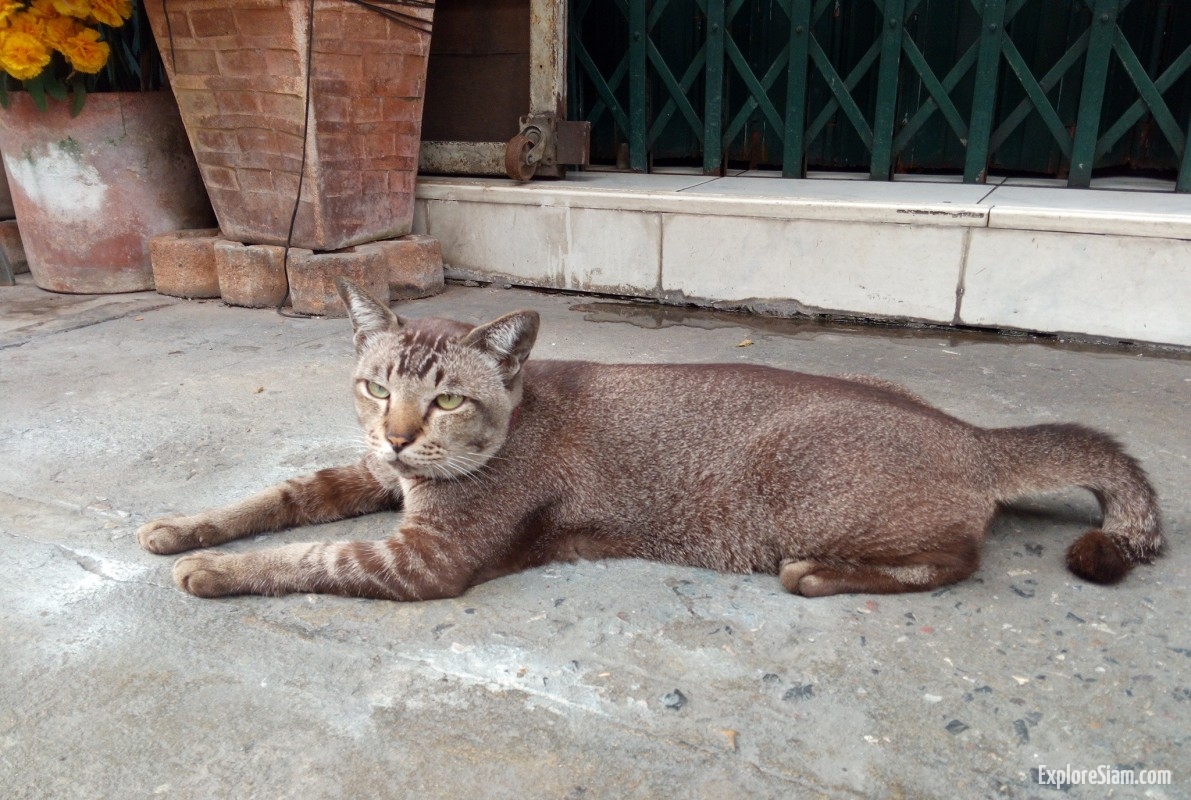Thailand, a country known for its rich culture, stunning landscapes, and friendly people, also boasts a fascinating feline presence. Cats in Thailand play various roles, from revered temple guardians to charming street strays, weaving themselves into the daily life and culture of this Southeast Asian nation.
Temple Guardians
In Thailand, cats are often found lounging around the serene grounds of Buddhist temples. These temple cats, or “wat cats”, are more than just casual visitors; they are cherished protectors of sacred spaces. The monks and devotees welcome these cats, who help maintain the temples by catching mice and even snakes. Their presence is considered auspicious, adding to the spiritual ambiance of these holy sites.
The role of cats in temples extends beyond mere pest control. In many cases, they become part of the temple community, forming bonds with the monks and regular visitors. Monks often feed the cats and ensure they are well-cared for, seeing them as sentient beings deserving of compassion and respect. The cats, in turn, provide companionship and a sense of tranquility, embodying the Buddhist principles of kindness and harmony.
Temple cats are known for their affectionate and sociable nature. Unlike their more aloof counterparts in other parts of the world, Thai cats enjoy human interaction and often approach visitors for a gentle pat or a treat. Their friendly demeanor and graceful presence make them beloved by locals and tourists alike. Visitors to temples often find themselves charmed by these feline residents, who add to the overall experience of serenity and reverence.
The Call of the Thai Cat
While many people around the world call cats with a familiar “here, kitty kitty”, in Thailand, a different sound is used. Thais summon cats with the call “meo”, mimicking the sound of a cat’s meow. This distinct cultural practice highlights the close bond between Thais and their feline friends. The cats, responding to this unique call, often come trotting over, ready for attention.
This unique way of calling cats is not just a charming quirk; it reflects the deep integration of cats into Thai daily life. The call “meo” resonates through neighborhoods, markets, and temple grounds, signifying a request for the company of these beloved animals. It’s a reminder of the cultural nuances that make Thailand unique and showcases the affectionate relationship between Thais and their cats.

Unique Physical Traits
One of the most notable features of Thai cats is their distinctive tails. Many Thai cats have short or kinked tails, a trait often attributed to their lineage with the bobtail breed. This genetic characteristic sets them apart from other cats and adds to their charm. These short-tailed cats are a common sight, whether they are temple dwellers or street wanderers.
The bobtail trait is believed to have historical and cultural significance. According to local legend, the kinked tails of these cats were once used by royalty to secure precious rings, keeping them safe. Today, these tails serve as a distinguishing feature, making Thai cats easily recognizable and adding to their unique appeal. The variation in tail length and shape among Thai cats adds to the diversity and richness of the country’s feline population.
Street Strays
In the bustling streets of Thailand’s cities and towns, stray cats are a familiar sight. These cats navigate the urban landscape with ease, living off the generosity of locals and the occasional meal from tourists. Despite their tough exterior, street cats in Thailand are known for their resilience and adaptability.
Communities often look out for these strays, providing food and shelter where they can. In some areas, efforts are made to spay and neuter street cats to control the population humanely. These community-driven initiatives reflect the compassionate spirit of the Thai people towards their feline companions.
Street cats in Thailand exhibit a remarkable ability to thrive in diverse environments. From busy markets to quiet alleyways, these cats have adapted to a variety of settings, demonstrating their resourcefulness. Many street cats form loose colonies, creating social structures that help them survive. These colonies often have designated feeding areas, where kind-hearted locals leave food and water for the cats.
Despite the challenges they face, street cats in Thailand often display a friendly and approachable demeanor. They are accustomed to human presence and frequently seek out interaction, whether it’s a scratch behind the ears or a warm lap to curl up on. This interaction with humans helps to blur the line between stray and pet, making these cats an integral part of the urban tapestry.
Cultural Significance
Cats hold a special place in Thai culture and folklore. They are often seen as symbols of good luck and prosperity. In traditional Thai beliefs, a cat in the house is said to bring good fortune. This cultural reverence for cats extends to various aspects of Thai life, from literature to art, where cats are depicted as graceful and mystical creatures.
Historical records and ancient texts often feature cats as revered animals. In Thai folklore, cats are believed to have the ability to ward off evil spirits and bring blessings to their owners. This belief is reflected in the care and respect given to cats across the country. Whether they are living in temples or on the streets, cats are treated with a level of reverence that highlights their cultural importance.
In Thai art, cats are frequently depicted in paintings, sculptures, and literature. These artistic representations capture the elegance and mystery of cats, celebrating their role in Thai society. The presence of cats in various cultural forms underscores their significance and the deep connection Thais feel towards these animals.
The Bobtail Connection
The genetic lineage of Thai cats includes the bobtail breed, known for its short, stubby tail. This distinctive trait is widely seen among Thai cats, giving them a unique and endearing appearance. The bobtail’s presence in Thailand is a testament to the country’s rich history of feline diversity.
The bobtail trait is not only a physical characteristic but also a symbol of the historical and cultural exchanges that have shaped Thailand’s cat population. The bobtail breed’s introduction to Thailand and its integration into the local feline gene pool illustrate the country’s openness to new influences and its ability to embrace diversity.
Cats and Community
In Thai communities, cats are more than just pets; they are part of the social fabric. Whether in temples, homes, or on the streets, cats are treated with kindness and respect. This deep-rooted cultural practice underscores the harmonious relationship between humans and animals in Thailand.
The community-oriented approach to caring for cats reflects broader societal values of compassion and mutual respect. In many neighborhoods, informal networks of cat lovers work together to ensure that both pet and stray cats receive food, medical care, and affection. These efforts are often coordinated through social media groups and local organizations, showcasing the modern ways in which traditional values are upheld.
In addition to grassroots efforts, there are also organized initiatives aimed at improving the welfare of cats in Thailand. These include spay and neuter programs, vaccination drives, and adoption events. These initiatives help to manage the cat population and improve the overall health and well-being of cats across the country.
Final Thoughts
From the tranquil temple grounds to the vibrant city streets, cats in Thailand are an integral part of the country’s cultural and social landscape. Their roles as temple guardians and street survivors showcase their adaptability and importance in Thai society. With their affectionate nature and unique traits, Thai cats continue to captivate the hearts of locals and visitors alike, embodying the spirit of this beautiful and welcoming country.
Thailand’s cats, with their distinctive personalities and cultural significance, offer a glimpse into the country’s rich tapestry of life. Whether you encounter a serene temple cat or a spirited street stray, you will find that these feline companions add an extra layer of charm and intrigue to any visit to Thailand.





